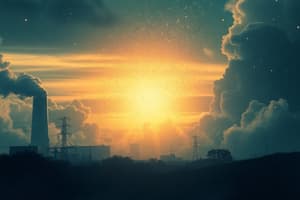Podcast
Questions and Answers
Which human activity contributes most significantly to the release of harmful chemicals into the atmosphere, leading to air pollution?
Which human activity contributes most significantly to the release of harmful chemicals into the atmosphere, leading to air pollution?
- Natural volcanic eruptions
- Evaporation of water from oceans
- Burning fossil fuels in power plants and automobiles (correct)
- Photosynthesis by plants
Nitrogen constitutes approximately 20% of the air we breathe.
Nitrogen constitutes approximately 20% of the air we breathe.
False (B)
Name two natural sources of particulate matter found in the air.
Name two natural sources of particulate matter found in the air.
Volcanic eruptions and dust storms
The presence of harmful chemicals in the air in quantities that can damage human health and the environment is known as ______.
The presence of harmful chemicals in the air in quantities that can damage human health and the environment is known as ______.
Match the following air pollutants with their primary source:
Match the following air pollutants with their primary source:
Which of the following is NOT a primary component of air?
Which of the following is NOT a primary component of air?
The burning of carbon-rich fuels primarily releases oxides of sulfur and nitrogen into the atmosphere.
The burning of carbon-rich fuels primarily releases oxides of sulfur and nitrogen into the atmosphere.
Besides their use in refrigerators and air conditioners, list a common application for chlorofluorocarbons (CFCs).
Besides their use in refrigerators and air conditioners, list a common application for chlorofluorocarbons (CFCs).
Besides soot and fly ash, ______ particles are often present in the exhaust fumes of automobiles and power plants, contributing to air pollution.
Besides soot and fly ash, ______ particles are often present in the exhaust fumes of automobiles and power plants, contributing to air pollution.
Which of the following primarily occurs during the burning of fossil fuels in thermal power plants and vehicles?
Which of the following primarily occurs during the burning of fossil fuels in thermal power plants and vehicles?
Flashcards
Air pollution
Air pollution
The presence of chemicals in the air in quantities harmful to human health and the environment.
Particulate matter
Particulate matter
Tiny particles suspended in the air, originating from volcanic eruptions, dust storms, burning of fossil fuels, exhaust fumes, and power plants.
Chlorofluorocarbons (CFCs)
Chlorofluorocarbons (CFCs)
Gases commonly used as coolants in refrigerators and aerosol propellants. They contribute to ozone depletion.
Oxides of sulfur and nitrogen
Oxides of sulfur and nitrogen
Signup and view all the flashcards
Carbon dioxide and carbon monoxide
Carbon dioxide and carbon monoxide
Signup and view all the flashcards
The air around us
The air around us
Signup and view all the flashcards
Percentage of nitrogen in the air
Percentage of nitrogen in the air
Signup and view all the flashcards
Percentage of oxygen in the air
Percentage of oxygen in the air
Signup and view all the flashcards
Percentage of carbon dioxide in the air
Percentage of carbon dioxide in the air
Signup and view all the flashcards
Percentage of other gases in the air
Percentage of other gases in the air
Signup and view all the flashcards
Study Notes
Air Composition
- Air consists of many gases and dust particles
- Nitrogen makes up 78.08% of the air
- Oxygen accounts for 20.95% of the air
- Carbon dioxide is 0.03% of the air
- Other gases comprise 0.97% of the air
Air Pollution
- Air pollution is the presence of harmful chemicals in the air
- These chemicals are released via natural processes and human activities
- Air pollution can harm human health and the environment
Particulate Matter
- Particulate matter includes the tiny particles suspended in the air
- Natural sources of particulate matter are volcanic eruptions, dust storms, burning of fossil fuels in thermal plants, and forest fires.
- Additional sources are Exhaust fumes from automobiles, power plants(soot), fly ash, and lead particles.
Chlorofluorocarbons (CFCs)
- Chlorofluorocarbons or freons are used as coolants in refrigerators and air conditioners
- Chlorofluorocarbons or freons are used as propellants in aerosol spray cans
- Chlorofluorocarbons are present in home insulation, plastic foam, and throwaway metallic cans
Burning Fossil Fuels
- Burning fossil fuels like coal and petroleum in thermal power plants and automobiles releases oxides of sulphur and nitrogen into the air.
Burning Carbon-Rich Fuels
- Burning carbon-rich fuels like firewood, coal, and petroleum releases carbon dioxide and carbon monoxide into the atmosphere
Studying That Suits You
Use AI to generate personalized quizzes and flashcards to suit your learning preferences.




